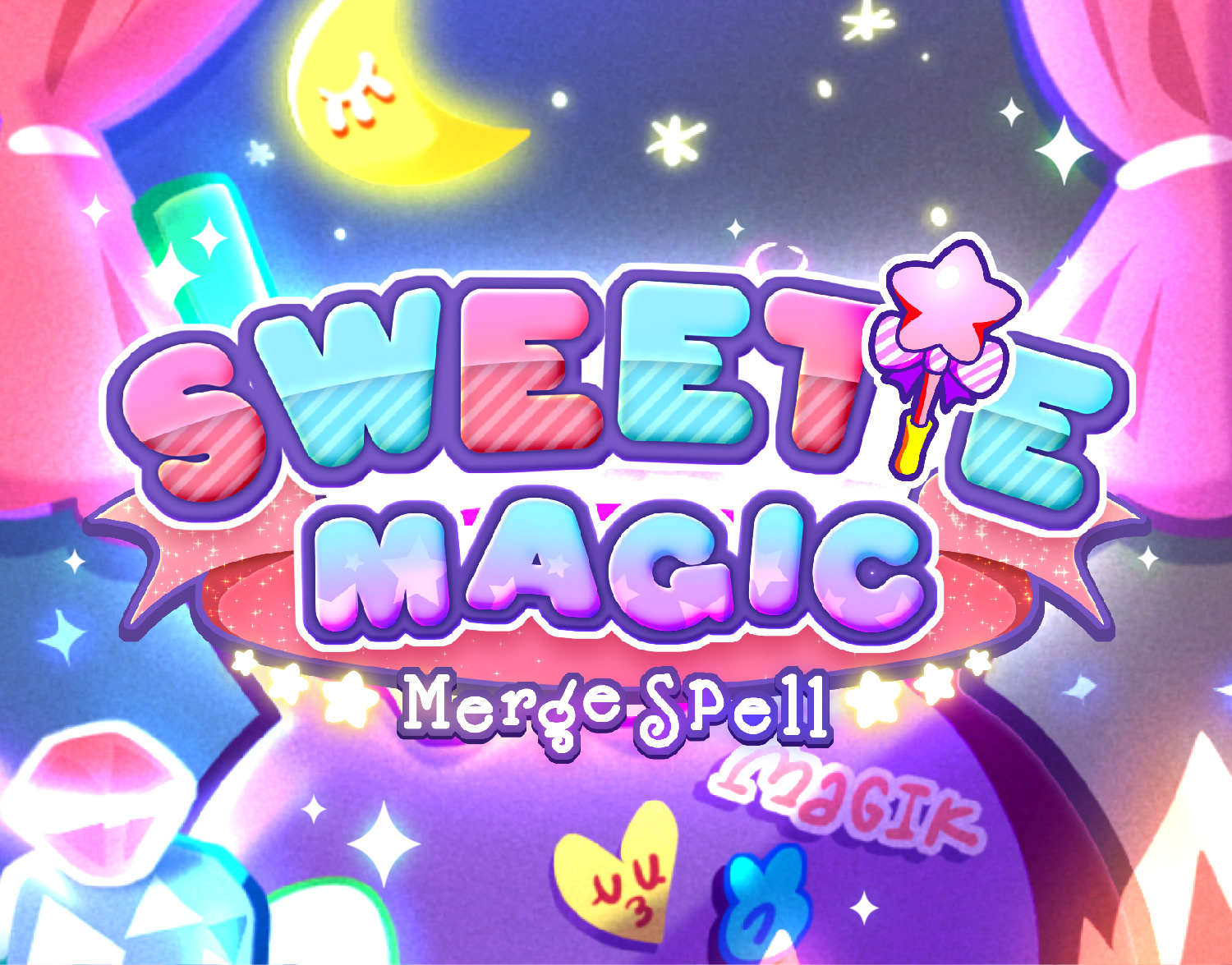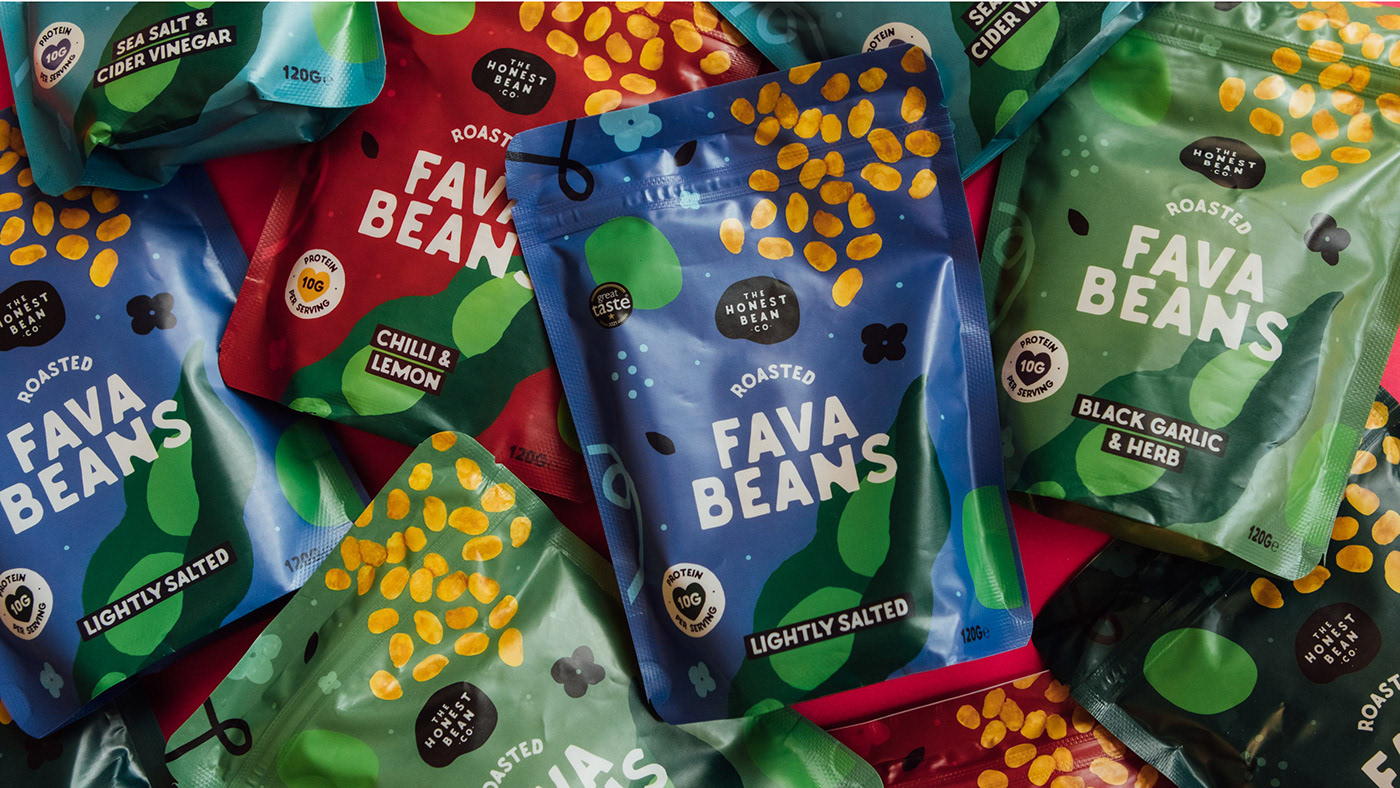
T H E L I V I N G C O M M U N I T Y
A&D (MSc01 ARC) Sustainable-Tectonic Architecture:
Integrating Social Sustainability And Climate Impact
A&D (MSc01 ARC) Sustainable-Tectonic Architecture:
Integrating Social Sustainability And Climate Impact
Finalization of the project: January 2021
Note: Project has been conducted in a group of five people in collaboration with Rikke Hviid Lysgaard Iversen,
Katrine Mitzi Koustrup, Mathilde Slot and Magnus Schrøder Pedersen.
Katrine Mitzi Koustrup, Mathilde Slot and Magnus Schrøder Pedersen.
Recognition: The Common Square illustration from the current project was used as the lead poster
of the international architectural student competition organized by Archasm
and was displayed on multiple sites such as Archdaily.
Recognition 2: "The Settlers" are a real user group that got introduced to this MSc01 semester project and welcomed it with applause. The meeting resulted in professional cooperation on the actual real project for Levefællesskabet Lindemosehuse in Arden. Moreover, current project proposal had its temporary exhibition in Arden throughout 2021 and later got requested by The Living Community to stay in exhibition permamently.
ABOUT
The aim of the project was to create a community that encourages solidarity with nature and between humans with simultaneously maintained personal individuality, all achieved by implementing ideas from adaptive, integrated and biophilic design to ensure social and environmental sustainability now and in the future.
Integrated design process has been crucial for creating solutions that have a strong architectural character, but also live up to Zero Energy standards due to applied passive and active strategies, especially microclimatic ones.
Based on the thought “Happy planet - Happy human” and a real user group, current project is a realistic proposal for a self-sufficient sustainable ECO-community for approximately 120 residents.
VISION
The Living Community positioned at the outskirts of Arden accommodates the need for sustainable communities that provide equal terms for both planet and humans. Here the settlers live in solidarity with nature and both benefit from each other. The settlers live in close relation to one another, and the built environment creates inspiring spaces to meet, interact and share ideas and hopes for the future. Joint ownership and teamwork creates the scene for a community that puts nature in focus. Though the community can only function through the unity, the private space has assigned a high priority. Small dwellings with plan solutions providing flexible spaces that can be personalized by an individual human, address the individual’s need for peace and relaxation, so renewed energy can be given back to the community and the planet. The indoor space takes inspiration from biophilic design principles, to increase the contact with nature and create comfortable spaces for the settlers to live in. The unique possibilities that occur with a site close to Rold forest on an old field create the foundation of the built environment, so the history and beauty of the surroundings are well preserved and become the identity of the community.
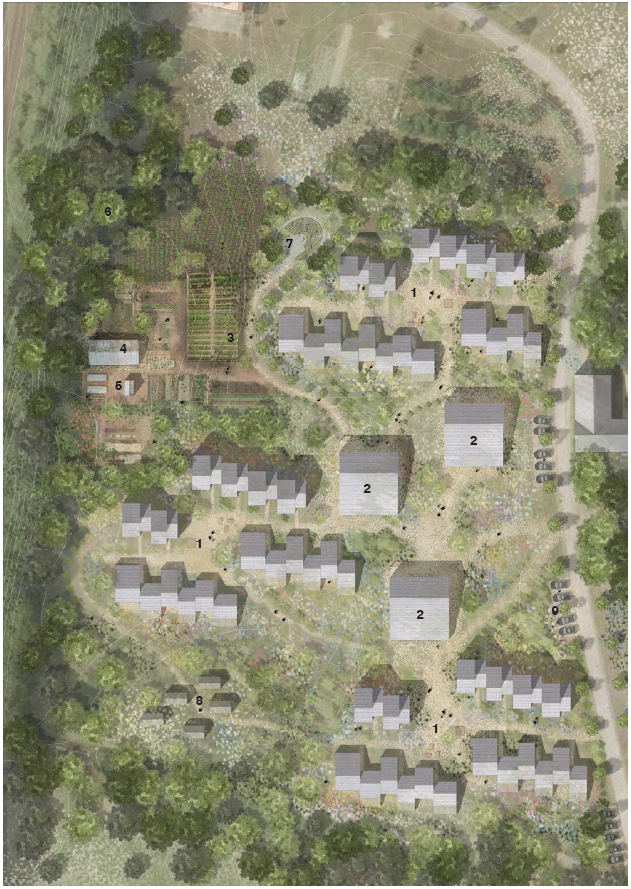
Master Plan
1. Cluster
2. Common House
3. Agricultural fields
4. Greenhouse
5. Hen house
6. Dense vegetation
7. Amphitheater
8. Tiny houses
9. Parking spaces
2. Common House
3. Agricultural fields
4. Greenhouse
5. Hen house
6. Dense vegetation
7. Amphitheater
8. Tiny houses
9. Parking spaces
MASTERPLAN
The Living Community is located in the outskirts of Arden, Denmark, surrounded by forest, agriculture and fresh air that forms the foundation of a new sustainable community. The project focuses on providing diversity both in nature and in social interactions, and therefore consists of 36 dwellings of different sizes and layout, divided into three clusters with nature all around. The dwellings in each cluster are placed close together to create a feeling of coherence and solidarity with the neighbours. The dense settlement creates the possibility for nature to spread through the site and in between the clusters. The green environment is an important factor in creating the identity of The Living Community - this is where the settlers find their common interest and where they grow the dreams of a new tomorrow.
In continuing the creation of the framework for an inclusive and diverse neighbourhood, each cluster consists of dwellings of respectively 60, 80 and 110 sq. m. to face the need of different settlers; single, couples and families, young and elderly. In addition, each cluster also comprises an outdoor square and a Common House that together form possibilities for a variety of different interactions between the neighbours.
The three Common Houses together form a Common Square - a center for the community, a more public space that with a path connects to an amphitheatre that allows for both community and public gatherings and events. The path leads through the agricultural fields and past a hen house as well as a greenhouse that creates the possibility to produce and harvest vegetables all year long. The fields grow into more dense vegetation consisting of fruit trees and bushes with berries and mark the end of the northern part of the community. The area is connected by bigger and smaller pathways that allow for people to move around and through the site by foot or by bike. The community is more or less car free as the parking spaces are scattered along the public road and the road inside the community functions only as a fire access road and road providing access in rare occassions like move-in / move-out or handicap transport. This allows for a safe and slower paced space where kids can run around and enjoy life.

Common Square illustration
COMMON SQUARE
The Common Square is the heart of The Living Community. When entering The Living Community through the Common square the experience starts. The area is big enough to gather the whole community and visitors. This is where you meet residents from the other clusters and maybe outside visitors, which makes this the most public area in the community. The Common Square connects the shared functions, for example, the agricultural fields and the amphitheatre, to the three clusters.

Public fields illustration
PUBLIC FIELDS
The agricultural fields are placed near the dwellings starting from the Common Houses ending in the northern part of the site. The common greenhouse placed besides the fields creates another environment for vegetables to grow. The fields are maintained by the settlers and the produced vegetables are used for common dinners in the Common Houses.

Greenhouse illustration

CLUSTER
Every type of dwelling is represented in each cluster to obtain diversity. Each cluster consists of four 110 sq. m dwellings, four dwellings of approximately 80 sq. m, two in two stories and two in one story and four 60 sq. m. dwellings where one is suitable for wheelchair users. Hereby both young and old can gather, meet and profit from each other.
The dwellings of the clusters are gathered in rows pushed back and forth to create private outdoor spaces for every dwelling. The pushed back entrance spaces creates a semi-private feeling and here the settlers can inhabit and create their own environment. The placement of the dwellings creates a variety of spaces and atmospheres in the cluster, as bigger and smaller distances between the dwellings are created. In the center of the cluster a common square is created. Here the cluster can gather for informal events and children can play together. Bicycle sheds and play areas
for the children define smaller rooms for the settlers to gather within the clusters. The bike sheds are placed inside the cluster in close connection to the dwellings to encourage traveling by bike instead of a car.
The dwellings of the clusters are gathered in rows pushed back and forth to create private outdoor spaces for every dwelling. The pushed back entrance spaces creates a semi-private feeling and here the settlers can inhabit and create their own environment. The placement of the dwellings creates a variety of spaces and atmospheres in the cluster, as bigger and smaller distances between the dwellings are created. In the center of the cluster a common square is created. Here the cluster can gather for informal events and children can play together. Bicycle sheds and play areas
for the children define smaller rooms for the settlers to gather within the clusters. The bike sheds are placed inside the cluster in close connection to the dwellings to encourage traveling by bike instead of a car.
CLUSTER SECTIONS
The differences in size of the space between the dwellings encourage different social interaction. The more narrow streets encourage informal meetings as well as nice private spaces outside the dwellings. The common square in the middle of the cluster creates an open space where everyone will meet and gather. The dwellings towards the north in two and three storeys have a semi-covered terrace towards the cluster where it is possible to enjoy the southern sun in the summer. The terraces are partly shielded by a fence, to ensure the privacy of the settlers while still being in contact with the community. The southern placed dwellings have a private terrace overlooking the fields towards the south.


Cluster isometry
PHOTOVOLTAICS
The Living Community is characterized by very distinct roofs that define each individual dwelling. The roofs allow for optimal conditions for photovoltaics as the northern rows of the cluster are in two and three stories and the southern rows are only in one story. Therefore, the dwellings do not shade for each other but provide great opportunities to harvest as much sun as possible. The photovoltaics is a means for the community to reach zero energy standards, and each cluster produces just around 47.900 kWh of energy per year (calculated with the tools Ladybug and Grasshopper)
which corresponds to the total energy production of nearly 148.300 kWh per year for the whole community.
which corresponds to the total energy production of nearly 148.300 kWh per year for the whole community.

ENERGY
The energy consumption is calculated for a row of three housing units containing two 60 sq. m dwellings and one 80 sq. m dwelling in one level. The building’s energy consumption reaches the energy frame BR18 before applying renewable energy with an energy demand of 35,5 kWh per sq. m per year. The low consumption is a result of the building design: highly insulated building envelope, low energy windows and their orientation and shading. When applying the photovoltaics the energy consumption reaches the energy frame Low energy with an energy demand of 10,6 kWh per sq. m per year. Even though the photovoltaics produce more energy, it is not shown in the energy frame calculation as no more than 25 kWh per sq. m per year of primary energy can reduce the energy frame (Trafik, bygge-og boligstyrelse 2018).
The energy consumption is calculated for a row of three housing units containing two 60 sq. m dwellings and one 80 sq. m dwelling in one level. The building’s energy consumption reaches the energy frame BR18 before applying renewable energy with an energy demand of 35,5 kWh per sq. m per year. The low consumption is a result of the building design: highly insulated building envelope, low energy windows and their orientation and shading. When applying the photovoltaics the energy consumption reaches the energy frame Low energy with an energy demand of 10,6 kWh per sq. m per year. Even though the photovoltaics produce more energy, it is not shown in the energy frame calculation as no more than 25 kWh per sq. m per year of primary energy can reduce the energy frame (Trafik, bygge-og boligstyrelse 2018).
The calculations show that the photovoltaics produce more than enough energy to cover the energy consumption on a yearly basis. The excess energy not used during summer will be sold back to the grid and during winter, when the photovoltaics do not produce enough, energy can be bought from the grid.

South cluster elevation
CLUSTER FACADES
The diverse shape of the dwellings creates a dynamic space between them. In the entrance the wood cladding is turned horizontal to mark it and the settlers can personalize the expression of their dwelling by choosing the color of the front door themselves. Windows are placed carefully in the facades of the dwellings to ensure privacy and daylight. The outer expression and shape of the Common House blend in with the dwellings in the community. The south facing glazed doors create a gentle transition between inside and outside.
MATERIALS AND EXPRESSION
The exterior cladding of the dwellings consist of slim cedar slats. The cedar is chosen as a sustainable choice compared to other species of timber. The wood is durable and contains fungicides and therefore does not need any further impregnation. When constructive wood preservation elements are implemented, the cladding will stay beautiful and healthy for many years and is therefore considered a sustainable choice. The wood will age with grace and turn gray with a glimmer of silver creating a lively facade. Due to wind and rain the different oriented facades will age uniquely and the cladding will within the years become diverse and show the beautiful aging through time. Photovoltaics are implemented on the southern faced roofs to collect solar energy. The northern faced roof consists of slates with the same expression as the photovoltaics. The entrance is marked with vertical cladding and a colored front door. The color of the door is a choice for the settlers to make, and will enhance the feeling of belonging.

North cluster elevation

Common House Section
COMMON HOUSE
Several entrances allow for a functional flow between the clusters and the common functions in the Common House. The south-facing dining area with space for approximately 40 people is placed in connection with the kitchen, and the double high room creates a connection between the two floors. The kitchen contains all required functions; storage rooms with varying temperature zones and a scullery for goods from the fields. The Common House also contains a common laundry room with washing machines and tumble dryers in connection with a covered outdoor space for drying cloth. The two floors are connected with centrally placed stairs with a slide for children and childish grownups. A playing net is spread across the staircase, a biophilic design principle that introduces risk, in connection with a free zone that can be utilized for a playground or used as a space for yoga or any other activity. Three rooms can be utilized for workshops and creative space or for office rooms and as they are equipped with sliding walls, it provides flexibility to increase the size of the rooms.

Common House Plans

BIOPHILIC DESIGN
Biophilic design is a research area that attempts to study behaviors and interactions of humans with their environment and implement it into architecture. It is learning from nature and human relation and applying gained knowledge of such in the designing process in order to improve human health and general well-being. Biophilic design became for us one of the tools to achieve social sustainability.

Aspects such as visual connection with nature that is stimulating and calming. Dynamic and diffused light showing signs of time and movement. Connection to Natural Systems bringing awareness of seasons and cycles of life and evoking a relationship to a greater whole. Using Natural Materials that feel rich, warm and authentic. We provided Prospect understood as an unblocked view in a form of partition heights but also open floorplans giving a sense of safety and control. You will find Refuge in a form of various niches and lofts providing a sense of retreat and withdrawal – for work, protection, rest or healing. There is also Risk and Peril understood as a threat followed by a reliable safeguard in a form of playing net and double heights or even glazed offices, all of that bringing a feeling of excitement and intrigue, which is worth exploring. Also outside there is plenty of stimuli. Sensory gardens stimulating senses from all angles. Mystery labyrinths created by natural environment making one want to understand and explore more. Or natural fences made with help of purely vegetation used as a tool to control borders of the Living Community with, at the same time, maintained sense of freedom.

CIRCULAR COMMUNITY
Different housing units ensure a diverse community and oblige the need of different settlers during all stages of life. An elderly that has become single is able to move to a smaller housing unit and a couple that becomes partners can move to a bigger one. The different housing units make it possible for people to stay in the same community even though life changes.

Elevations 60 sq. m unit in one story
FLOOR PLANS 60 sq. m unit
The 60 sq. m dwelling is created to perfectly fit a single person or a couple. The dwelling is entered through the north-facing facade with storage and a sitting niche. Towards south, the kitchen is placed and is extended into a greenhouse where herbs and vegetables can be harvested. The greenhouse prolongs the outdoor seasons as it functions as a sunspace. In the kitchen a small dining niche is implemented, creating a cosy corner. The living room is placed in connection with the kitchen and they both harvest the warm southern sun through the large windows creating a nice thermal indoor climate. In the northern end of the dwelling, the bedroom is placed to ensure a
pleasant slightly colder thermal indoor climate. A small window is placed in the eastern wall of the bedroom to let in the morning sun.
pleasant slightly colder thermal indoor climate. A small window is placed in the eastern wall of the bedroom to let in the morning sun.
In each cluster, a wheelchair accessible dwelling is incorporated to enhance diversity and solidarity. The dwelling possesses the same qualities as the 60 sq. m dwelling, just made suitable for wheelchair users.
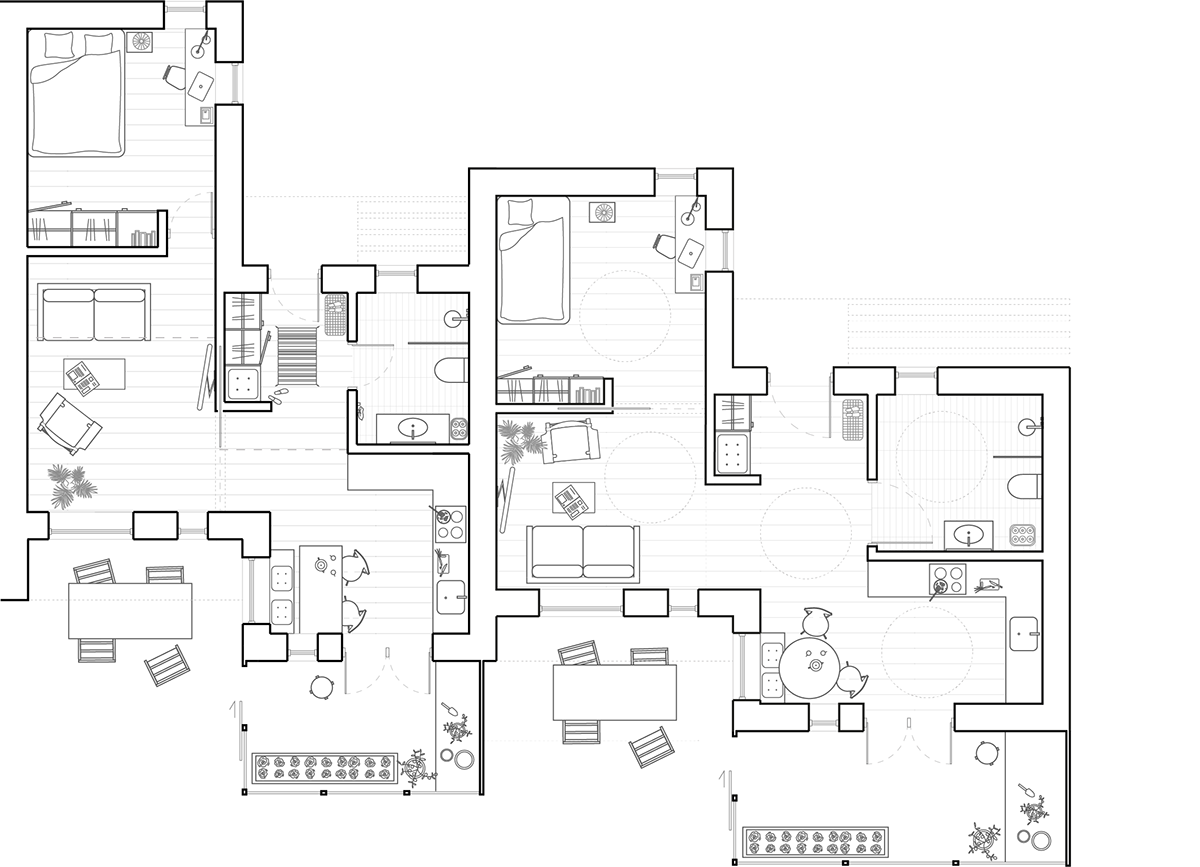
Floor plan 60 sq. m unit in one story + handicap 62 sq. m unit

Section length 60 sq. m unit in one story
SECTIONS 60 sq. m unit
The entrance of the dwelling is covered by a pergola where plants can grow and bring nature close to the dwelling. Between the living room and the kitchen a sliding door is placed, so it is possible to divide the rooms whenever cooking or having guests over. Above the sliding door, a window is integrated to make sure that light can still be shared between the rooms. The roof of the greenhouse attached to the kitchen follows the roof of the dwelling and becomes a natural extension of the house.

Section width 60 sq. m unit in one story

Elevations 80 sq. m unit in one story
FLOOR PLANS 80 sq. m unit
The 80 sq. m dwelling is created to fit the couple who needs a bit more space or the couple with one child. The dwelling is created with the same principles as the 60 sq. m dwelling just with an extra room to use either as an office space, a hobby room or a children’s room.
The plans and the individual rooms are carefully created and sized to be flexible in use and in the arrangement of furniture. Therefore the dwellings can be changed to fit the specific users and their needs, as they can utilize the spaces differently.

Floor plan 80 sq. m unit in one story

Interior render
INTERIOR RENDER
The small window in the southern facade creates a prospect from the entrance through the dwelling and connects the indoor with outdoor. The southern facade between the kitchen and the greenhouse is made of hempcrete to store heat from the greenhouse which can be utilized during night. The hempcrete is textured and creates different tactile stimulations in comparison with the smooth wooden boards. The wood is introduced as an interior surface in every dwelling to bring nature and warmth into the buildings. In the ceiling, visible rafters give orientation and diversify the expression of the ceiling and enhance light play. The visible construction brings the high space closer to human scale creating comfortable, cosy rooms.

Elevations 80 sq. m unit in two stories
FLOOR PLANS 110 and 80 sq. m units
The 110 sq. m dwelling is created to fit any kind of family. The dwelling is divided into three stories and entered from the south. In the entrance, there is an integrated closet for storage of coats and shoes. The kitchen is towards the south with a door and a big window facing the outdoor terrace creating a close connection to the cluster. The kitchen is placed in a double hight room, connecting the first-floor to the rest of the dwelling. This makes the different floors of the dwelling seem closer connected and it is possible to obtain a visual and vocal connection. The dining area and living room is placed three steps down towards the north with a view to the open fields. On the second-floor two kids, rooms and a bathroom is placed. By placing the kids’ rooms on the second-floor their daily plays become a part of the common areas and parents and children will have a higher level of coherence during the day. The third-floor is intended as the parents’ section of the dwelling. The eastern wall is utilized for closets and a small working table making it possible to work focused from home without interruptions. An east-facing window allows for the morning sun in the bedroom, and the settlers can watch the sky from the bed through a skylight in the roof.
The 80 sq. m dwelling is created to fit the couple who needs a bit more space or the couple with one child. The dwelling is created with the same principles as the 110 sq. m dwelling, but in two floors.

Floor plans 110 sq. m unit in three stories and 80 sq. m unit in two stories

3D Section 110 sq. m unit in three stories
SECTIONS 110 sq. m unit
The southern roof carefully executed to harvest energy from the sun gives the dwelling an unique identity. The interior space is influenced by the roof and it creates a double height room connecting two stories in the dwelling. On the ground floor three steps divide the kitchen and the dining area which enhances the different atmospheres of the spaces.
On the ground floor a built-in bookcase creates a cosy corner for watching TV and gathering with the family. The other corner of the living room contains a dining area with a built-in niche under the staircase. On the second floor two rooms are placed, one with a loft above to utilize the space underneath the ceiling.
On the ground floor a built-in bookcase creates a cosy corner for watching TV and gathering with the family. The other corner of the living room contains a dining area with a built-in niche under the staircase. On the second floor two rooms are placed, one with a loft above to utilize the space underneath the ceiling.
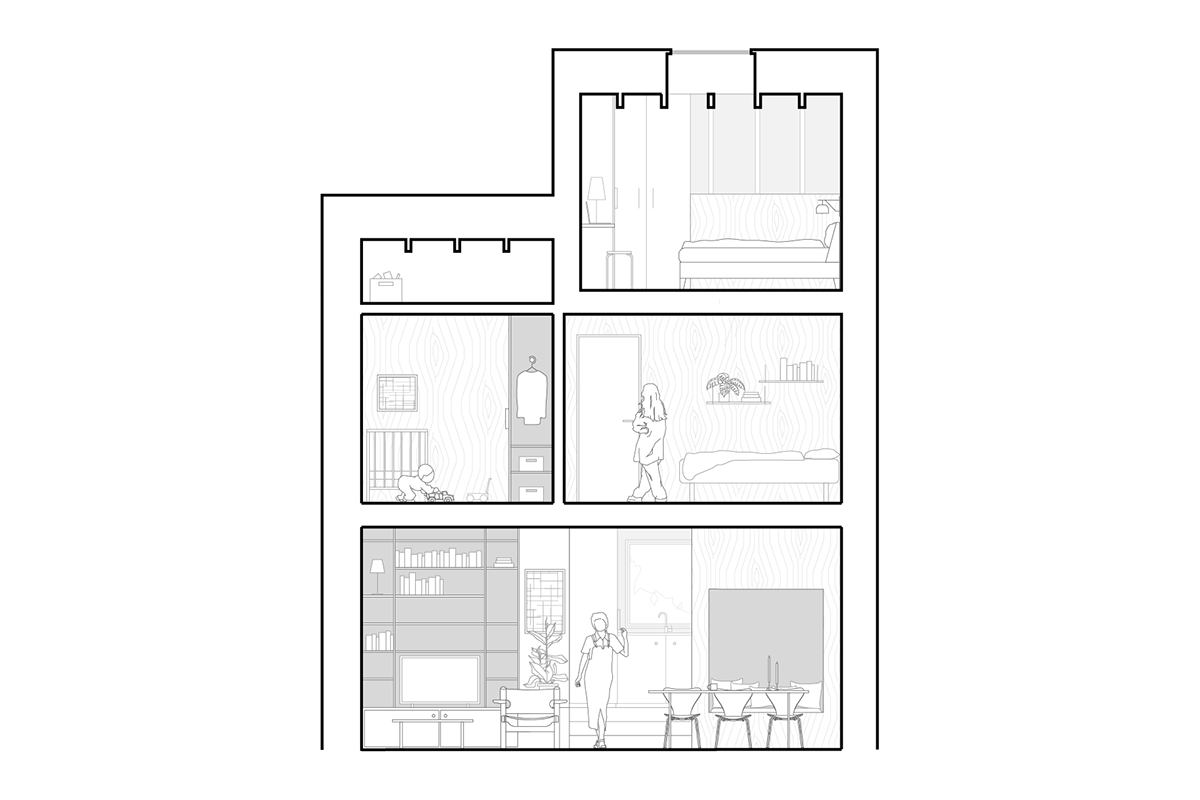
Section 110 sq. m unit in three stories
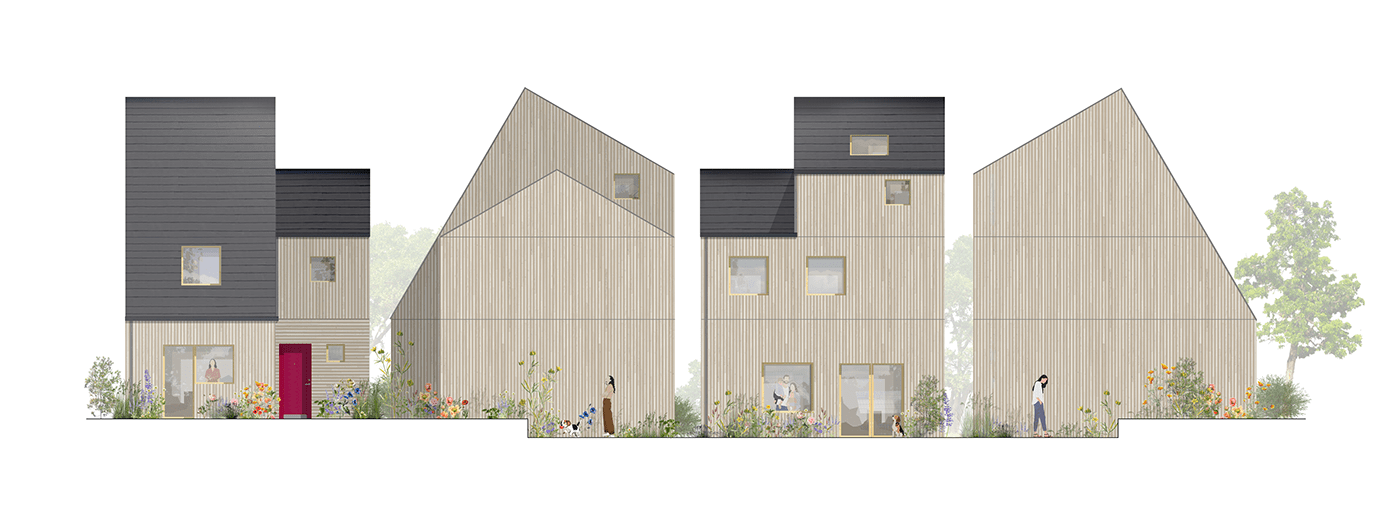
Elevations 110 sq. m unit in three stories
ECO-FRIENDLY CONSTRUCTION
Sustainable building materials applied in the construction were a very big focus for us in the current project and we tried to reach for organic and recyclable materials wherever possible as yet another way to achieve environmental sustainability. The following cut through the most essential construction elements shows principles that can be applied in most areas of our project.
The roof is a warm roof construction, allowing for the structural 150 mm rafters to be aesthetically visible in the indoor space. For the insulation purposes wood fibre insulation is used - placed in accordance with TræfiberDanmark® manufacturer guidelines. TFDK Intermediate insulation batts (with a thickness of 200 mm plus additional 160 mm) are applied as a primary insulation and TFDK Pro Underroof and wind barrier plate with a thickness of 35 mm is placed on the outer side of the roof - holding the batten system that supports SolarTag T-ROOFTM roof tiles with solar cells. For the external wall construction wooden stud frame structural system is used with compound studs of a width of 280 mm, fitting TFDK Flex wood fibre insulation in between and between internal batten furring. Vertical wood cladding is applied as an external finish, with space between to allow for air to flow through and decrease the chance of root. Energy efficient triple glazed Velfac 200 Energy windows are inserted.
Since all buildings are resting directly on the ground, having a direct contact to the soil, it was assessed that it is too risky to apply any form of organic insulation in that area. The standard, well known polystyrene insulation (300 mm in total) is applied as an exception from the “natural materials” design criteria to mitigate any possible risks of failure in the
construction, expecting that this approach would appear to be more sustainable in the long run than experimenting with unsure alternatives. Insulation is resting on the Monarflex RMB400 Radon Barrier Membrane. For the same reason we are using concrete for the slab and foundation system, reaching for Unicon Uni-Green® more eco-friendly concrete that can also help us with heat storage capacity of the building envelope.
construction, expecting that this approach would appear to be more sustainable in the long run than experimenting with unsure alternatives. Insulation is resting on the Monarflex RMB400 Radon Barrier Membrane. For the same reason we are using concrete for the slab and foundation system, reaching for Unicon Uni-Green® more eco-friendly concrete that can also help us with heat storage capacity of the building envelope.
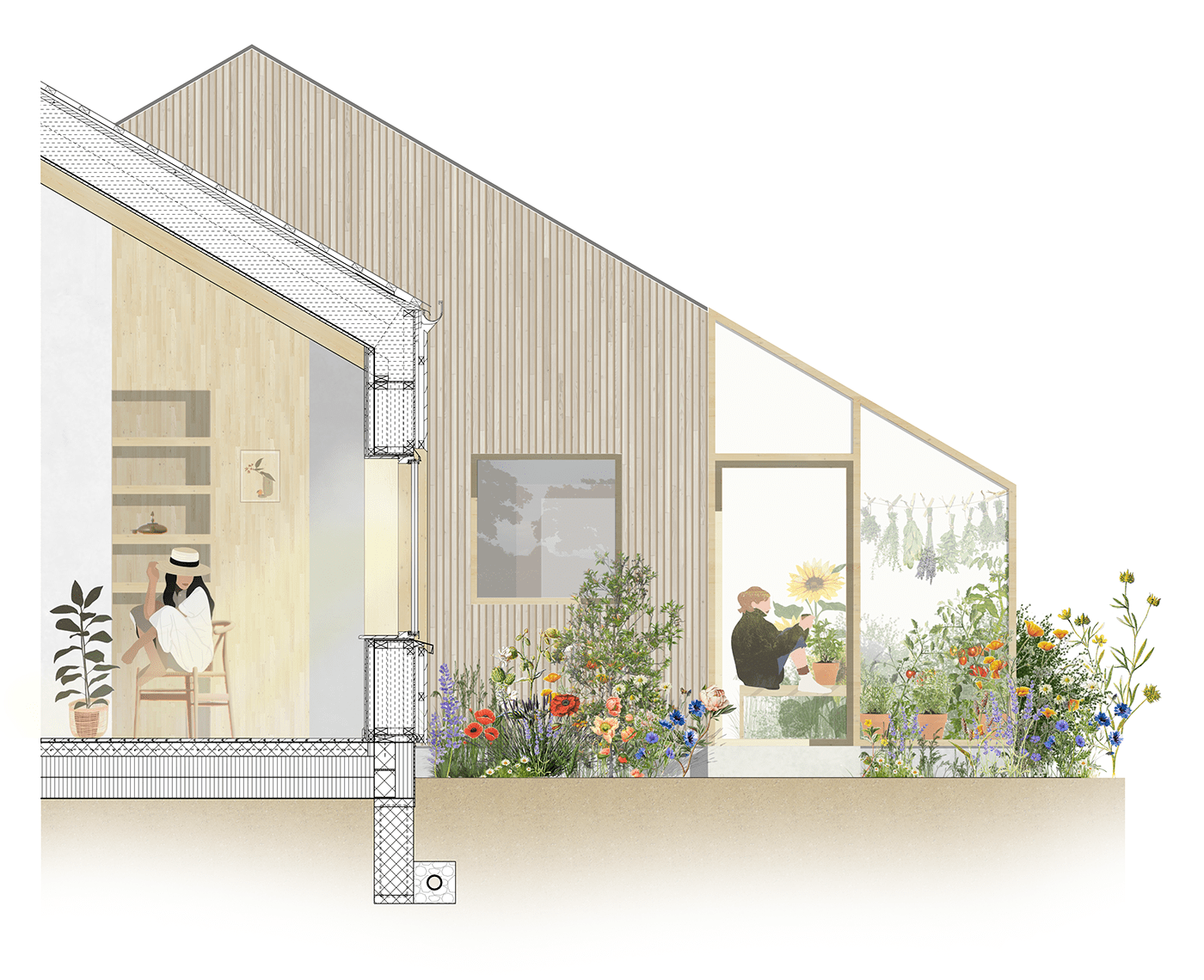
Construction Section with Details




REFLECTION
It was the first time we were dealing with a real user group, which became to be a very exciting journey for us. The users naturally share the primary vision for the Living Community, but they are also 4 separate individuals and THAT, appeared to be a guidepost for us throughout the design process. We wondered how to create a Community that would encourage solidarity with nature and fellow humans with, at the same time, maintained individuality - meeting the human need for both belonging and separateness. Fellowship and privacy. Even the final expression of the Living Community is a little metaphor of the users – each building have its own individual touch and feel with maintained common expression. They are different, but together constitute of a whole. Unity in diversity.
Also our small motto came from the user group – "Happy planet, Happy human" seems to be fitting to the ideology of the Living Community, which smoothly brings us to all the discussions about social and environmental sustainability permeating and sometimes contrasting each other. It was a challenge to balance it all out. Beside organization of the community, functional aspects and social layers, technical solutions like energy frames, indoor climate, renewable energy, ethically sourced materials and aesthetics made the project even more complex leaving us with truly Integrated Design Process.
Final posters representing the project:





